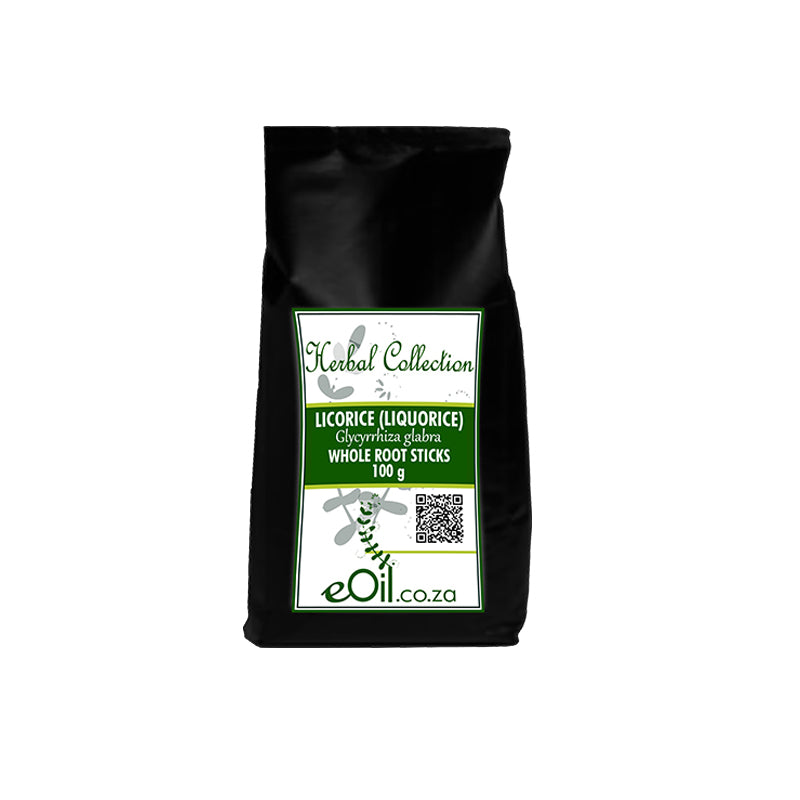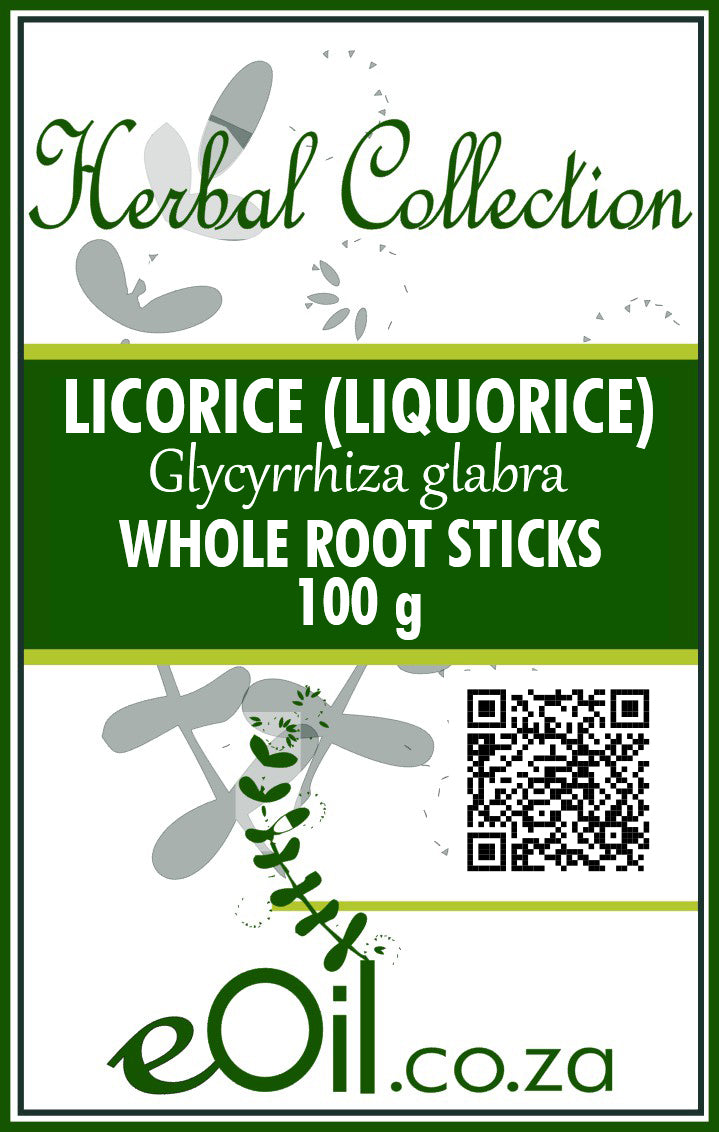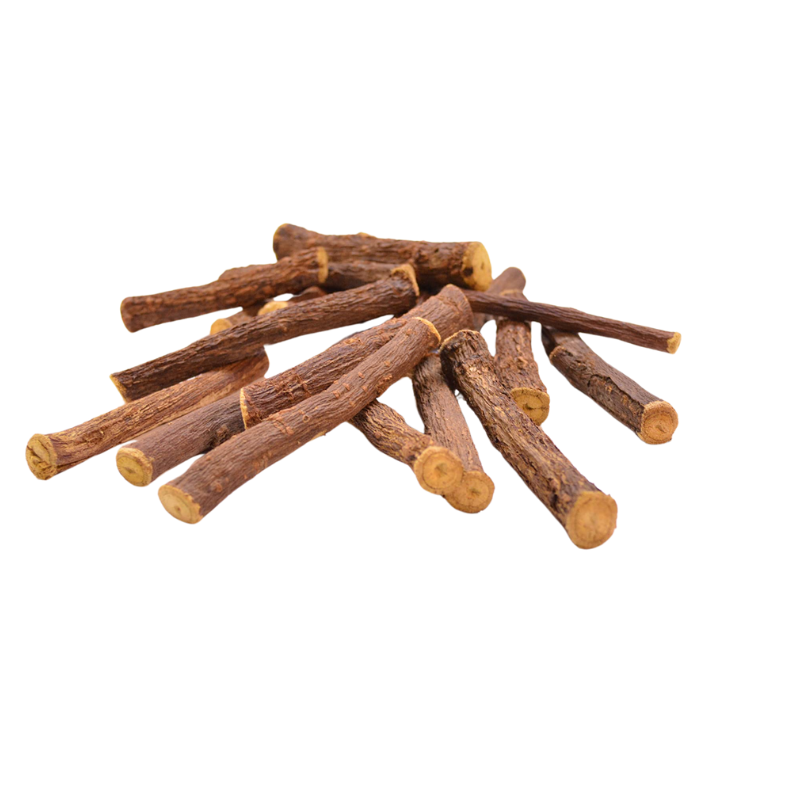Liquorice - Licorice Whole Root Stick Whole - Herbal Collection
Liquorice - Licorice Whole Root Stick Whole - Herbal Collection - 100 GR is backordered and will ship as soon as it is back in stock.
Description
Description
Liquorice - Licorice Whole Root Stick Whole 100 g - Herbal Collection
Glycyrrhiza glabra
length around 10 cm each stick
TRADITIONALLY USED FOR
Digestion Aid.
Traditionally, liquorice root tea was used to help ease digestive problems and soothe symptoms associated with nausea and upset stomach.
The tea also boasts antispasmodic effects, which may help with gas and bloating. Recent research shows there may be some benefits for healthy digestion
INFORMATION
Source : http://www.wikiphyto.org/wiki/Reglisse
Reference on http://www.wikiphyto.org
Translation in English by Google Translate (go to the page of the source linked | on Chrome cellphones go on the 3 dots on the top right and select translate in your preferred language | on laptop right click your mouse and select option translate when hoovering on the page
plant name
Licorice, Sweetwood , Sweetroot , Sweetwood , liquorice (English), Gan Cao or ( Gancao (Chinese), Radix glycyrrhizae
International Latin denomination
- ( Glycyrrhiza inflata Bat., Glycyrrhiza uralensis Risch.)
botanical family
Fabaceae subfamily Faboideae (ex - Papilionaceae , ex - Leguminosae )
Description and habitat
- Perennial herb that can reach and exceed 1 m in height, native to southern (var. typica) central and eastern Europe (var. glandulifera ) or Asia Minor (var. violacea )
- Highly developed underground parts, stoloniferous rhizome
- Imparipinnate compound leaves
- Small lilac or purplish blue papilionaceous flowers, gathered in elongated clusters
- The fruit is a flattened, seed-dented pod
History and tradition
- Its medicinal properties have been known since ancient times
- Its name comes from the Greek glykos (sweet) and rhiza (root)
- Theophrastus recommended it for ulcers in the 3rd century BC. JC and mentioned its effect of reducing the feeling of thirst
- The Greeks and Romans used it in asthma and ulcers
- In China, it is among the ten most important plants
- The Arabs used it against painful menstruation
- In Japan, it is used to induce ovulation in hyperandrogenic women.
- The Scythians and the armies of Alexander the Great used it to counter thirst when crossing deserts because of its mineralocorticoid effect (hyperaldosteronism)
Parts used
- Root and rhizome
Dosage forms available
- Licorice sticks
- Fluid extract
- Underground Part Mother Tincture
- EPS
Usual dosages
Composition
Main components of the plant
- Alkaloids
- Beta-amyrin type triterpene saponosides : majority glycyrrhizin (whose aglycone is glycyrrhetic acid or enoxolone = 18-β-glycyrrhetinic acid )
- Flavonoids and isoflavonoids , flavanones , chalcones : liquiritoside and isoliquiritoside , liquiritigenin , naringenin , glabridin , glabrene , glabrol , 3-hydroxyglabrol , 4'-O-methylglabridin , phaseollinisoflavane , hispaglabridin A and B, licochalcone , licoricidin
- Beta-sistosterol , stigmasterol , steroids with estrogenic activity in small quantities
- Polysaccharides , starches 25 - 30% ( coumarins ?)
- Salicylic acid
Main components of buds or young shoots
Main components of essential oil
Properties
Plant properties
- Increases the secretion of gastric mucus and decreases that of pepsinogens, gastric anti-ulcer [1] , preventive and curative role vis-à-vis gastric ulcers, inhibits the adhesion of Helicobacter pylori to the gastric wall ( polysaccharides ) [2 ]
- Flavonoids are antispasmodic ( liquiritoside and isoliquiritoside )
- Expectorant, mucolytic, facilitates expectoration, antitussive
- Antiviral, reduction of mortality and viral activity in herpes simplex virus encephalitis and influenza A virus pneumonia, in vitro antiviral activity against HIV-1, SARS-related coronavirus, respiratory syncytial virus, arbovirus, vaccinia virus and vesicular stomatitis virus [3]
- Glycyrrhizin is anti-bacterial and antiviral, glycyrrhetic acid is active against SARS coronavirus [4] , glycyrrhizin is more active than other molecules (ribavirin, 6-azauridine, pyrazofurin, mycophenolic acid [5] ) , anti-hepatotoxic, immuno-stimulant, healing
- Immunostimulant, increases phagocytosis, stimulates the production of T and B lymphocytes [6]
- Mineralocorticoid effects [7] and potentiation of corticosteroids (inhibition of 4.5 b-reductase responsible for the inactivation of steroid hormones), glycyrrhizin inhibits renal 11 beta-hydroxysteroid dehydrogenase-2 (= 11β-HSD2) and thus inhibits the conversion of cortisol into cortisone [8] , leading to water retention and hyperaldosteronism, arterial hypertension, hypernatremia, hypokalaemia, inhibition of the effects of cortisol (?), stimulation of melanogenesis (by glycyrrhetinic acids) genin, l ' glycyrrhetinic acid ( 18-β-glycyrrhetinic acid ) or enoxolone is responsible for the side effects, stimulation of renin by the kidney [9]
- Glycyrrhizic acid interferes with 17-beta-hydroxysteroid dehydrogenase, which catalyzes the conversion of androstenedione into testosterone, which would lead to a reduction in testosterone levels in men [10] as in women [11] , no effect found for salivary testosterone [12]
- Adaptogen [13]
- Memory stimulation [14] , [15] , by glabridin with anticholinergic effect (potential effect in Alzheimer's disease [16] , [17]
- Neuroprotective ( glabridin [18] and isoliquiritigenin [19] , isoliquiritigenin possesses a protective effect against mitochondrial damage and neuronal death of hippocampal neurons induced by glutamate [20] , and it protects the dopaminergic neurons from oxidative stress by regulating apoptosis [21] , anticonvulsant [22]
- Antidepressant [23]
- Protects against LDL oxidation [24] , anti-atherogenic [25] , antioxidant ( formononetin , glabridin , hemileiocarpine , hispaglabridin B , isoliquiritigenin , 4'-O-methylglabridin , paratocarpin B ) [26]
- Antihistamine [27]
- Anti-inflammatory ( glycyrrhizin ) by inhibition of prostaglandin E2 production by macrophages [28]
- Estrogenic effect: beta-sitosterol , stigmasterol , glabridin [29] , [30] , osteoblastic [31] and anti-osteoclastic effect [32]
- Glycyrrhetic acid would stimulate the natural conversion of testosterone into estrogen
- Glycyrrhizic acid interferes with 17ß-hydroxysteroid dehydrogenase, which catalyzes the conversion of androstenedione to testosterone [33]
- Antitumor activity (prostate cancer) by licochalcone [34] , anti-angiogenic, decreases VEGF production [35]
- Hepatoprotector [36]
- Nephroprotective ( glabridin ) [37]
- Healing
- Antibacterial [38] , antibacterial activity against methicillin- resistant Staphylococcus aureus (MRSA) by flavonoids ( licoricidin restores the effects of oxacillin) [39] , antifungal ( glabridin ) [40]
- Specialty of glycyrrhetic acid = enoxolone (INN) local anti-inflammatory => anal pruritus, vulvar, solar erythema, seborrheic dermatitis
- The sweetness of glycyrrhizin is 50 times greater than cane sugar
- Antiviral activity against DNA viruses ( Herpes ) and RNA viruses ( HIV virus ) [41] , but beware, in vitro activity
- In vitro inhibition of Helicobacter pylori strains with MIC of 50 to 400 mg/ml [42]
- A Chinese mixture (PHY906 based on peony , skullcap flower , licorice , and Chinese dates), shows an anti-inflammatory effect, decreases the expression of TNF-alpha in the intestine, protects the mucosa from the toxic effects of chemotherapy to irinotecan and restores the integrity of the epithelium [43]
Bud properties
Properties of essential oil
Directions
Indications of the whole plant (phytotherapy)
- Gastritis, gastric and duodenal ulcer due to Helicobacter pylori
- Angina, chronic bronchitis, asthma
- Lichen planus [44] , [45]
- Sun protection and vis-à-vis the stress of high mountains (mountain sickness) or water deprivation during hot weather
- Adrenal insufficiency
- Indications for corticosteroids, over a short period of time, relay of corticosteroids
- Female hirsutism, hyperandrogenism [46] , would cause ovulation in hyperandrogenic women
- Improves symptoms of letrozole-induced polycystic ovary syndrome in rats [47]
- Topical hemorrhoids, anal and vulvar pruritus
- Eczema, itching, skin ulcerations, insect bites, sunburn, seborrheic dermatitis, diaper rash
Indications of the bud (gemmotherapy)
Specific indications of essential oil (aromatherapy)
Known or suspected mode of action
- Mineralocorticoid effects by pseudo-hyperaldosteronism, causes a decrease in aldosterone and renin by interaction with 11-beta-OH-steroid dehydrogenase (monoglycuronide of glycyrrhetinic acids lowers it)
- Enoxolone is a topical steroid-like anti-inflammatory
Usual formulations
Regulations
- French Pharmacopoeia list A (underground part)
Possible side effects and precautions for use
- Pharmacokinetic interactions:
- Glycyrrhizin appears to be an inhibitor of CYP2B6 and 3A4 and PgP (conflicting studies)
- Pharmacodynamic interactions:
- Glycyrrhizin causes arterial hypertension and edema by sodium retention (pseudo-hyperaldosteronism), hypokalaemia, disorders of muscle contractility, cardiac abnormalities, hyperaldosteronism (sodium, chloride, water retention, increased potassium excretion, decreased diuresis)
- Glycyrrhizin intoxication leads to primary pseudo-hyperaldosteronism. Glycyrrhizin has no direct mineralocorticoid activity (affinity for mineralocorticoid receptors, 10 thousand times lower than that of aldosterone). It exerts its toxicity through enzymatic inhibition of 11-ß-hydroxysteroid dehydrogenase. Cortisol, which cannot then be converted into cortisone at the renal level, binds to mineralocorticoid receptors reproducing the symptoms of hyperaldosteronism (renal elimination of potassium and water-sodium retention) while there is an overall braking of the renin-angiotensin system -plasma aldosterone [48]
- Avoid association with:
- Digitalis (increased sensitivity)
- Diuretics and stimulant laxatives (risk of hypokalaemia)
- Corticosteroids (additive effect, worsening of hypokalaemia)
- Oral contraceptives (increased effects of glycyrrhizin )
- Antihypertensives (modification of effect)
- Omeprazole (decrease in plasma concentrations)
- Avoid the use of licorice in hormone-dependent cancers because of its estrogenic properties
- Licorice is used in the composition of "Soshiho-tang", a preparation of traditional Chinese or Japanese medicine plants, with good tolerance (with Bupleurum falcatum , Pinellia ternate , Scutellaria baicalensis , Zizyphus jujuba , Panax ginseng , Glycyrrhiza uralensis , Zingiber officinale ) [49]
Bibliographic references
- Go↑ Khayyal MT, el-Ghazaly MA, Kenawy SA, Seif-el-Nasr M, Mahran LG, Kafafi YA, Okpanyi SN. Antiulcerogenic effect of some gastrointestinally acting plant extracts and their combination. Arzneimittelforschung. 2001;51(7):545-53. PMID 11505785
- Go↑ Wittschier N, Faller G, Hensel A. Aqueous extracts and polysaccharides from liquorice roots (Glycyrrhiza glabra L.) inhibit adhesion of Helicobacter pylori to human gastric mucosa. J Ethnopharmacol. 2009 Sep 7;125(2):218-23. PMID 19607905
- Go↑ Fiore C, Eisenhut M, Krausse R, Ragazzi E, Pellati D, Armanini D, Bielenberg J. Antiviral effects of Glycyrrhiza species. Phytother Res. 2008 Feb;22(2):141-8. doi: 10.1002/ptr.2295. PMID: 17886224.
- Go↑ Hoever G, Baltina L, Michaelis M, Kondratenko R, Baltina L, Tolstikov GA, Doerr HW, Cinatl J Jr. Antiviral activity of glycyrrhizic acid derivatives against SARS-coronavirus. J Med Chem. 2005 Feb 24;48(4):1256-9. PMID 15715493
- Go↑ Cinatl J, Morgenstern B, Bauer G, Chandra P, Rabenau H, Doerr HW. Glycyrrhizin, an active component of liquorice roots, and replication of SARS-associated coronavirus. Lancet. 2003 Jun 14;361(9374):2045-6. doi: 10.1016/s0140-6736(03)13615-x. PMID 12814717
- Go↑ Yang G, Yu Y. Immunopotentiating effect of traditional Chinese drugs--ginsenoside and glycyrrhiza polysaccharide. Proc Chin Acad Med Sci Peking Union Med Coll. 1990; 5(4):188-93. PMID 2293226
- Go↑ Kageyama Y, Suzuki H, Saruta T. Glycyrrhizin induces mineralocorticoid activity through alterations in cortisol metabolism in the human kidney. J Endocrinol. 1992 Oct;135(1):147-52. PMID 1431677
- Go↑ Soma R, Ikeda M, Morise T, Miyamori I, Takeda R. Effect of glycyrrhizin on cortisol metabolism in humans. Endocr Reg. 1994 Mar;28(1):31-4. PMID 7949011
- Go↑ Al-Qarawi AA, Abdel-Rahman HA, Ali BH, El Mougy SA. Liquorice (Glycyrrhiza glabra) and the adrenal-kidney-pituitary axis in rats. Food Chem Toxicol. 2002 Oct;40(10):1525-7. PMID 12387318
- Go↑ Armanini D, Bonanni G, Mattarello MJ, Fiore C, Sartorato P, Palermo M. Licorice consumption and serum testosterone in healthy man. Exp Clin Endocrinol Diabetes. 2003 Sep;111(6):341-3. PMID 14520600
- Go↑ Armanini D, Mattarello MJ, Fiore C, Bonanni G, Scaroni C, Sartorato P, Palermo M. Licorice reduces serum testosterone in healthy women. Steroids. 2004 Oct-Nov;69(11-12):763-6. PMID 15579328
- Go↑ Josephs RA, Guinn JS, Harper ML, Askari F. Liquorice consumption and salivary testosterone concentrations. Lancet. 2001 Nov 10;358(9293):1613-4. PMID 11716893
- Go↑ Winston David, Maimes Steven. Adaptogens: Herbs for Strength, Stamina, and Stress Relief, Healing Arts Press, 2007
- Go↑ Dinesh Dhingra, Milind Parle, SK Kulkarni. Memory enhancing activity of Glycyrrhiza glabra in mice. Journal of Ethnopharmacology, Volume 91, Issues 2–3, April 2004, Pages 361–365. PMID 15120462
- Go↑ Parle M, Dhingra D, Kulkarni SK. Memory-strengthening activity of Glycyrrhiza glabra in exteroceptive and interoceptive behavioral models. J Med Food. 2004 Winter;7(4):462-6. PMID 15671690
- Go↑ Cui YM, Ao MZ, Li W, Yu LJ. Effect of glabridin from Glycyrrhiza glabra on learning and memory in mice. PlantaMed. 2008 Mar;74(4):377-80. PMID 18484526
- Go↑ Dhingra D, Parle M, Kulkarni SK. Comparative brain cholinesterase-inhibiting activity of Glycyrrhiza glabra, Myristica fragrans, ascorbic acid, and metrifonate in mice. J Med Food. 2006 Summer;9(2):281-3. PMID 16822217
- Go↑ Yu XQ, Xue CC, Zhou ZW, Li CG, Du YM, Liang J, Zhou SF. In vitro and in vivo neuroprotective effect and mechanisms of glabridin, a major active isoflavan from Glycyrrhiza glabra (licorice). Life Sci. 2008 Jan 2;82(1-2):68-78. PMID 18048062
- Go↑ Zhan C, Yang J. Protective effects of isoliquiritigenin in transient middle cerebral artery occlusion-induced focal cerebral ischemia in rats. Pharmacol Res. 2006 Mar;53(3):303-9. PMID 16459097
- Go↑ Yang EJ, Min JS, Ku HY, Choi HS, Park MK, Kim MK, Song KS, Lee DS. Isoliquiritigenin isolated from Glycyrrhiza uralensis protects neuronal cells against glutamate-induced mitochondrial dysfunction. Biochem Biophys Res Commun. 2012 May 18;421(4):658-64. doi: 10.1016/j.bbrc.2012.04.053. PMID 22538371
- Go↑ Hwang CK, Chun HS. Isoliquiritigenin isolated from licorice Glycyrrhiza uralensis prevents 6-hydroxydopamine-induced apoptosis in dopaminergic neurons. Biosci Biotechnol Biochem. 2012;76(3):536-43. PMID 22451397
- Go↑ Shirish D. Ambawade, Veena S. Kasture, Sanjay B. Kasture. Anticonvulsant Activity of Roots And Rhizomes of Glycyrrhiza Glabra. Indian Journal of Pharmacology 2002; 34: 251-255 [1]
- Go↑ Dhingra D, Sharma A. Antidepressant-like activity of Glycyrrhiza glabra L. in mouse models of immobility tests. Prog Neuropsychopharmacol Biol Psychiatry. 2006 May;30(3):449-54. PMID 16443316
- Go↑ B Fuhrman, S Buch, J Vaya, PA Belinky, R Coleman, T Hayek, M Aviram. Licorice extract and its major polyphenol glabridin protect low-density lipoprotein against lipid peroxidation: in vitro and ex vivo studies in humans and in atherosclerotic apolipoprotein E-deficient mice. Am J Clin Nutr August 1997 vol. 66 no. 2,267-275. PMID 9250104 [2]
- Go↑ Belinky PA, Aviram M, Fuhrman B, Rosenblat M, Vaya J. The antioxidative effects of the isoflavan glabridin on endogenous constituents of LDL during its oxidation. Atherosclerosis. 1998 Mar;137(1):49-61. PMID 9568736
- Go↑ Chin YW, Jung HA, Liu Y, Su BN, Castoro JA, Keller WJ, Pereira MA, Kinghorn AD. Anti-oxidant constituents of the roots and stolons of licorice (Glycyrrhiza glabra). J Agric Food Chem. 2007 Jun 13;55(12):4691-7. PMID 17516657
- Go↑ Imanishi N, Kawai H, Hayashi Y, Yatsunami K, Ichikawa A. Effects of glycyrrhizin and glycyrrhetinic acid on dexamethasone-induced changes in histamine synthesis of mouse mastocytoma P-815 cells and in histamine release from rat peritoneal mast cells. Biochem Pharmacol. 1989 Aug 1;38(15):2521-6. PMID 2474295
- Go↑ Ohuchi K, Kamada Y, Levine L, Tsurufuji S. Glycyrrhizin inhibits prostaglandin E2 production by activated peritoneal macrophages from rats. Prostaglandins Med. 1981 Nov;7(5):457-63. PMID 6798590
- Go↑ Snait Tamir, Mark Eizenberg, Dalia Somjen, Naftali Stern, Rayah Shelach, Alvin Kaye, Jacob Vaya. Estrogenic and Antiproliferative Properties of Glabridin from Licorice in Human Breast Cancer Cells. Cancer Res October 10, 2000 60; 5704
- Go↑ Somjen D, Knoll E, Vaya J, Stern N, Tamir S. Estrogen-like activity of licorice root constituents: glabridin and glabrene, in vascular tissues in vitro and in vivo. J Steroid Biochem Mol Biol. 2004 Jul;91(3):147-55. PMID 15276622
- Go↑ Choi EM. The licorice root derived isoflavan glabridin increases the function of osteoblastic MC3T3-E1 cells. Biochem Pharmacol. 2005 Aug 1;70(3):363-8. PMID 15922308
- Go↑ Somjen D, Katzburg S, Vaya J, Kaye AM, Hendel D, Posner GH, Tamir S. Estrogenic activity of glabridin and glabrene from licorice roots on human osteoblasts and prepubertal rat skeletal tissues. J Steroid Biochem Mol Biol. 2004 Aug;91(4-5):241-6. PMID 15336701
- Go↑ Robert A Josephs, Jennifer S Guinn, Michelle L Harper, Frederick Askari. Liquorice consumption and salivary testosterone concentrations. Research letters, Volume 358, Number 9293, November 2001 [3]
- Go↑ Fu Y, Hsieh TC, Guo J, Kunicki J, Lee MY, Darzynkiewicz Z, Wu JM. Licochalcone-A, a novel flavonoid isolated from licorice root (Glycyrrhiza glabra), causes G2 and late-G1 arrests in androgen-independent PC-3 prostate cancer cells. Biochem Biophys Res Commun. 2004 Sep 10;322(1):263-70. PMID 15313200
- Go↑ Sheela ML, Ramakrishna MK, Salimath BP. Angiogenic and proliferative effects of the cytokine VEGF in Ehrlich ascites tumor cells is inhibited by Glycyrrhiza glabra. Int Immunopharmacol. 2006 Mar;6(3):494-8. PMID 16428085
- Go↑ Rajesh MG, Latha MS. Protective activity of Glycyrrhiza glabra Linn. on carbon tetrachloride-induced peroxidative damage. Indian J Pharmacol [serial online] 2004 [cited 2012 Feb 20];36:284-7. Available from: http://www.ijp-online.com/text.asp?2004/36/5/284/12646
- Go↑ Fukai T, Satoh K, Nomura T, Sakagami H. Preliminary evaluation of antinephritis and radical scavenging activities of glabridin from Glycyrrhiza glabra. Fitoterapia. 2003 Dec;74(7-8):624-9. PMID 14630165
- Go↑ Mitscher LA, Park YH, Clark D, Beal JL. Antimicrobial agents from higher plants. Antimicrobial isoflavanoids and related substances from Glycyrrhiza glabra L. var. typical. J Nat Prod. 1980 Mar-Apr;43(2):259-69. PMID 7381508
- Go↑ Hatano T, Kusuda M, Inada K, Ogawa TO, Shiota S, Tsuchiya T, Yoshida T. Effects of tannins and related polyphenols on methicillin-resistant Staphylococcus aureus. Phytochemistry. 2005 Sep;66(17):2047-55. PMID 16153408
- Go↑ Fatima A, Gupta VK, Luqman S, Negi AS, Kumar JK, Shanker K, Saikia D, Srivastava S, Darokar MP, Khanuja SP. Antifungal activity of Glycyrrhiza glabra extracts and its active constituent glabridin. Phytother Res. 2009 Aug;23(8):1190-3. PMID 19170157
- Go↑ Liu J, Manheimer E, Tsutani K, Gluud C. Medicinal herbs for hepatitis C virus infection: a Cochrane hepatobiliary systematic review of randomized trials. Am J Gastroenterol. 2003 Mar;98(3):538-44. PMID 12650784
- Go↑ M. Malek Jafarian et al. Licorice against Helicobacter pylori -Mashhad University of medical sciences dept microbiology, Mashad, Iran (3rd international congress on health, environment and natural products Mashad, Iran, 25 - 28 sept 2004)
- Go↑ Lam W, Bussom S, Guan F, Jiang Z, Zhang W, Gullen EA, Liu SH, Cheng YC. The four-herb Chinese medicine PHY906 reduces chemotherapy-induced gastrointestinal toxicity. Sci Transl Med. 2010 Aug 18;2(45):45ra59. PMID 20720216
- Go↑ Nagao Y, Sata M, Tanikawa K, Kameyama T. A case of oral lichen planus with chronic hepatitis C successfully treated by glycyrrhizin. Kansenshogaku Zasshi. 1995 Aug;69(8):940-4. PMID 7594790
- Go↑ Da Nagao Y, Sata M, Suzuki H, Tanikawa K, Itoh K, Kameyama T. Effectiveness of glycyrrhizin for oral lichen planus in patients with chronic HCV infection. J Gastroenterol. 1996 Oct;31(5):691-5. PMID 8887036
- Go↑ Arentz S, Abbott JA, Smith CA, Bensoussan A. Herbal medicine for the management of polycystic ovary syndrome (PCOS) and associated oligo/amenorrhoea and hyperandrogenism; a review of the laboratory evidence for effects with corroborative clinical findings. BMC Complementary and Alternative Medicine 2014, 14:511 (18 December 2014) Full text abstract
- Go↑ Yang H, Kim HJ, Pyun BJ, Lee HW. Licorice ethanol extract improves symptoms of polycytic ovary syndrome in Letrozole-induced female rats. Integr Med Res. 2018 Sep;7(3):264-270. doi: 10.1016/j.imr.2018.05.003. PMID 30271715
- Go↑ VIGITOX, Antipoison Center, Lyon Pharmacovigilance Center http://www.centres-antipoison.net/lyon/vigitox39/Vigitox_N39_janvier_2009.pdf
- Go↑ Shin IS, Lee MY, Kim Y, Seo CS, Kim JH, Shin HK. Subacute toxicity and stability of Soshiho-tang, a traditional herbal formula, in Sprague--Dawley rats. BMC Complementary and Alternative Medicine 2012, 12:266 (27 December 2012) Abstract , Provisional PDF
- Asl MN, Hosseinzadeh H. Review of pharmacological effects of Glycyrrhiza sp. and its bioactive compounds. Phytother Res. 2008 Jun;22(6):709-24. PMID 18446848 full text
- Shapna Sultana, Afroza Haque, Kaiser Hamid, Kaniz Fatima Urmi, Sumon Roy. Antimicrobial, cytotoxic and antioxidant activity of methanolic extract of Glycyrrhiza glabra. Agriculture and Biology Journal of North America 2010, 1(5): 957-960 full pdf
- K. Ghedira, P. Goetz, R. Le Jeune. Glycyrrhiza glabra L. (Fabaceae) Licorice. PHYTOTHERAPY (CONTINUING EDUCATION), Volume 8, Number 3, 185-190
- Wichtl Max, Anton Robert. Therapeutic plants: Tradition, officinal practice, science and therapy. Ed. Tec & Doc. Cachan. 1999.
- Bruneton J. Pharmacognosy, Phytochemistry, Medicinal Plants. Ed. Tec and Doc. 1997.
- American Botanical Council comprehensive bibliography
CAUTION
Store in a cool, dry place, away from light. Keep tightly closed, away from the reach of Children and pets.
Do not exceed the daily dose.
This product is not intended to prevent or cure any form of illness or disease.
If you are pregnant or nursing ; If you have a medical condition or are in the course of medical treatment ; If you are programmed for theater/operation in the near future, please consult your healthcare practitioner before using this product.
This product cannot replace a varied and balanced diet and a healthy lifestyle.
This product has not been evaluated by the SAHPRA for its quality, safety or intended use.
For More Information please check our General Safety Herbal products Page

Liquorice - Licorice Whole Root Stick Whole - Herbal Collection - 100 GR is backordered and will ship as soon as it is back in stock.






